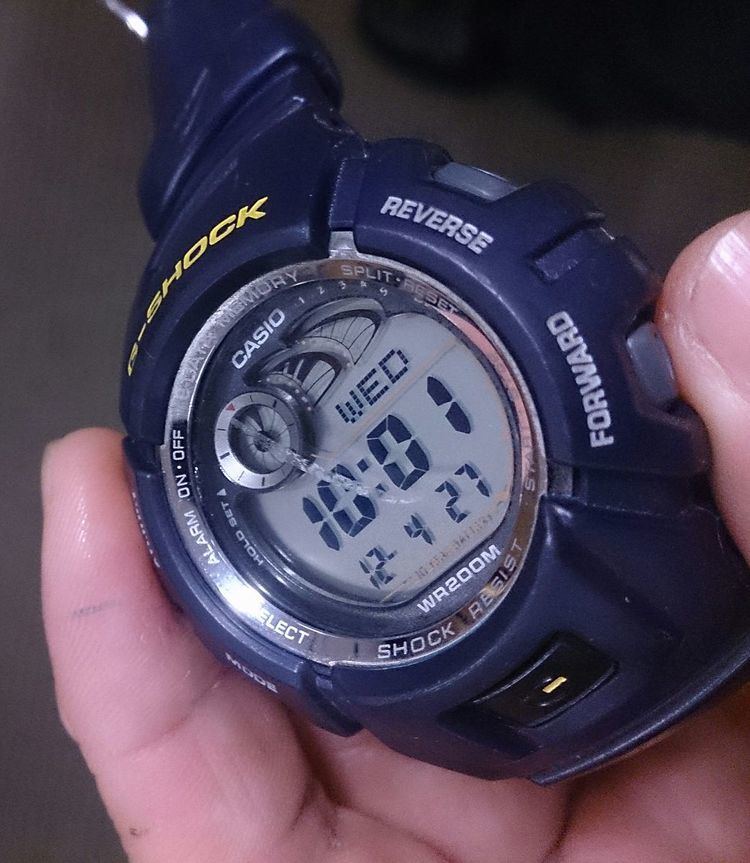Product type Watches | Markets Worldwide | |
 | ||
Introduced April 1983; 33 years ago (1983-04) | ||
G-Shock is a line of watches manufactured by Casio, designed to resist mechanical shock and vibration. Its full form is Gravitational Shock. They are designed primarily for sports, military and outdoors-oriented activities; nearly all G-Shocks are digital or a combination of analog or digital and have a stopwatch feature, countdown timer, backlight and water resistance.
Contents
History
The first G-Shock, the Casio DW-5000C, was designed in 1983 by an engineer working for Casio named Kikuo Ibe. It was designed to have a 10-year battery life, be water resistant to 10 bar, and survive a 10m fall onto a hard surface. 200 prototypes were tested by dropping them from rooftops or third story windows.
The shock resistant design has 10 layers protecting the quartz timekeeping module, including a urethane rubber bumper, the stainless steel case, the hardened mineral glass watch crystal, the stainless steel screwed down caseback, and the "floating module" where the quartz mechanism floats free in a urethane foam cradle, with the outer buttons and LCD module attached with flexible cables. It was released in April 1983, seizing the unfilled market for highly functional watches. For the next few years Casio released several new models each year. The Baby-G series was released in 1991, targeted towards women. The popularity of G-Shocks increased rapidly throughout the 1990s, and by 1998, 19 million G-Shocks had been sold worldwide and there seemed to be a peak in demand as over 200 new models were released in that year alone.
Current models
The line of watches now includes atomic clock synchronization and solar battery. The Cockpit Series G-Shock is the official timekeeper of Nismo Racing. Many newer G-Shocks feature metal (steel or titanium) banding and analog timekeeping.
Twice a year the basic models are updated. New limited models are introduced more frequently through the year. As with Swatch watches, G-Shocks have become collectors items.
Casio also produces collaboration models, often with popular fashion brands, like A Bathing Ape (Bape), Stussy, Xlarge, KIKS TYO, Nano Universe, Levi's, Lifted Research Group, as well as Coca Cola, Pulp68 Skateshop, Lucky Strike and Marlboro.
G-Shock watches are popular with mountaineers, firemen, paramedics, people working in the offshore, police officers, astronauts, film directors (Tony Scott was often pictured wearing a GW-3000B, as is Ron Howard and Francis Ford Coppola) and soldiers. Ex-Special Forces-British SAS soldier Andy McNab mentions in several of his novels how his fictional character Nick Stone relies on a G-Shock watch. According to Mark Bowden's book Blackhawk Down, the DELTA Operators wore G-Shock watches during the combat events of 3 & 4 October 1993. Since then, G-Shock watches have become very popular with Special Forces groups in both American and other NATO nation units, due to their being "battle tested".
Models DW-5600C, DW-5600E, DW-5900, DW-6600, DW-6900 are flight-qualified for NASA space travel. Casio has updated the DW-5600E module, replacing the usual 1545 module with module number 3229 (in 2010).
In 2012, Casio released GB-6900, a Bluetooth-capable model of G-Shock. Casio claimed the battery life of 2 years on a single CR2032 battery.
Casio continues to add new features to G-Shock watches. Some include Tough Solar battery charging and Multiband 6 time synchronization through radio signals from six transmission stations worldwide. The GW-9400 Rangeman and GWN-1000 Gulfmaster models have a Triple Sensor with a digital compass, thermometer, and barometer/altimeter. The MTG-S1000, GW-A1000, and GPW-1000 feature Triple G Resist which includes resistance to shock, centrifugal gravity, and vibration. In 2014 Casio introduced the GPS Hybrid Wave Ceptor feature in the GPW-1000 Gravitymaster that allows the watch to synchronize the time through GPS signals and also adjusts the time zone automatically. The MRG-G1000 is also equipped with this feature.
Metal/Titanium Series
Origin Models/Squares
Vintage/Classic Models
G-Lide Surfing editions
These models were released in 1996, designed and specifically made for the surfing market. These models were the very first G-Shock watches to have a countdown timer. The countdown timers on these models were designed to count down for surfing competitions, so a surfer can keep track of the progress while competing on the water. Many of these models came equipped with a pair of strap adapters and a single one-piece resin or nylon band. These styles of band are also known as "crossband" in the Japanese domestic market. Resin bands for these models had open gaps or slits through the band. Casio refers to them as drainage slits; the idea is that water will drain out with no problems while in action when surfing. Most of these series models had a translucent band. These models were branded as X-Treme for the Japanese domestic market.
X-Treme Snow Board/Skateboard Editions
These models are identical to the surfing editions, and also released in 1996. They were designed for snowboarding and skateboarding competitors and competitions. The only difference is that these models came with nylon velcro bands.
Limited edition models
Modules
Frequent updates have produced a proliferation of modules with slightly varying feature sets:
